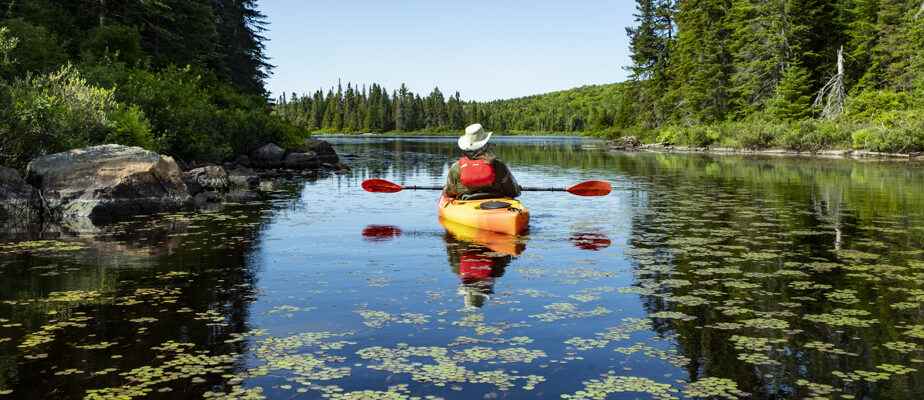Access to water is more difficult, but there is a very good reason for this: to protect fragile bodies of water against invasive species, such as the Eurasian watermilfoil and the zebra mussel.
Posted at 11:30 a.m.
This is what many shoreline owners have argued in very polite emails sent to The Press following the publication of a column on the difficult access to water.
The good news is that Canot Kayak Québec is well aware of this aspect of the problem and has suggestions for countering the spread of these exotic species without blocking access to bodies of water.
“It’s not by putting up barriers that we’re going to solve the problem,” says Pierre Marquis, general manager of Canot Kayak Québec. It’s not viable in the medium and long term because Quebecers will continue to want to go on the water. It’s more about discussion, about finding solutions together. »

PHOTO FRANÇOIS ROY, LA PRESSE ARCHIVES
Eurasian watermilfoil in a lake in the Laurentians
The threat of Eurasian watermilfoil and zebra mussels is very real. Eurasian watermilfoil, an exotic aquatic plant, reproduces so efficiently that it can reduce the biodiversity of bodies of water and affect boating, fishing and swimming.

PHOTO ALAIN ROBERGE, LA PRESSE ARCHIVES
Zebra mussels caught in Lake Massawippi
The tiny zebra mussel displaces native mussels and can clog drinking water intakes and prematurely age a body of water. A female can lay more than 100,000 eggs a year, says Sophie Payeur, director of the organization Bleu Massawippi.
Devastation in Estrie
Both species are particularly devastating in Estrie.
Lake Memphremagog is struggling with zebra mussels and Lake Massawippi saw its first mussels last fall. Since then, it’s been the commotion. “They have no predators, recalls Mme Payer. The way out is to remove them manually during dives. »
To control the introduction of invasive species, the accesses to Lake Massawippi are equipped with boat washing stations. Of course there are costs.
I understand those who are angry, but we are faced with a problem that concerns everyone.
Sophie Payeur, director of the Bleu Massawippi organization
Residents of Lake Selby, in Brome-Missisquoi, live in fear of the introduction of these invasive species.
“It is a small lake 0.8 km wide by 2 km long, it is perhaps 1 m deep on average, indicates François Charbonneau, president of the Association for the protection of the environment of the lake. Selby. Starting off, it’s a very fragile lake. »
The municipality of Dunham has created a small public access.
“A small family who would come for a picnic, who would like to go wading or show the children how to fish, we cannot be against that, declares Mr. Charbonneau. But don’t access water irresponsibly. »

PHOTO DAVID BOILY, LA PRESSE ARCHIVES
Canoes, kayaks and paddle boards have a shallow draft. These boats can therefore explore the smallest bays.
Canoes, kayaks and paddle boards too
The municipality has therefore established an access permit to ensure that boats coming from elsewhere are properly washed. We are talking about motorized and non-motorized boats. Because even canoes, kayaks and paddleboards can contribute to the problem of spreading invasive species.
“There’s no pollution, it’s quiet, it’s green as a mode of transport, but the behavior of the paddler can have an even greater impact than that of a person on board a motorized boat” , says Pierre Marquis, of Canot Kayak Québec.

PHOTO BERNARD BRAULT, PRESS ARCHIVES
Paddle board, canoe kayak, rowboat: whatever your boat, it must be washed before sailing on a new body of water.
He explains that, thanks to the shallow draft of their boats, paddlers can explore the smallest bays. “When you do that, you risk cutting segments of invasive plants with the paddle,” says Marquis.
The problem with these plants is that the cuttings have the ability to move around, take root elsewhere and generate a new plant.
Pierre Marquis, General Manager of Canot Kayak Quebec

PHOTO MARTIN TREMBLAY, PRESS ARCHIVES
A good pair of binoculars allows you to observe wildlife without having to go deep into the seagrass.
There is also a question of biodiversity: nesting species can also be disturbed by the presence of paddlers. “You easily get carried away by interest, you’ve just seen something, a type of bird, but it easily creates damage if you’re not careful. »
Paddlers can therefore do two very concrete things to combat the spread of invasive species: avoid walking in the bottom of bays and paddling in seagrass beds and, of course, wash their boat before dragging it into a new water.
“We have to raise public awareness and continue to educate people,” says Mr. Marquis. It is not by cutting access that we will necessarily control this. »
Suggested video
Everest differently
A rarity: spectacular images of Everest taken by a drone.
digit of the week
28 kg
This is the maximum weight of the raccoon in the fall. It can lose 50% of its weight in winter.

